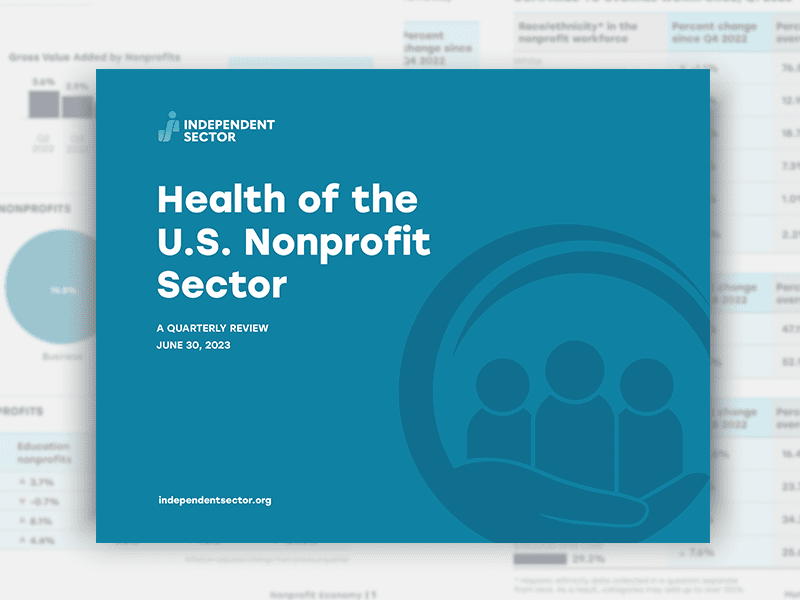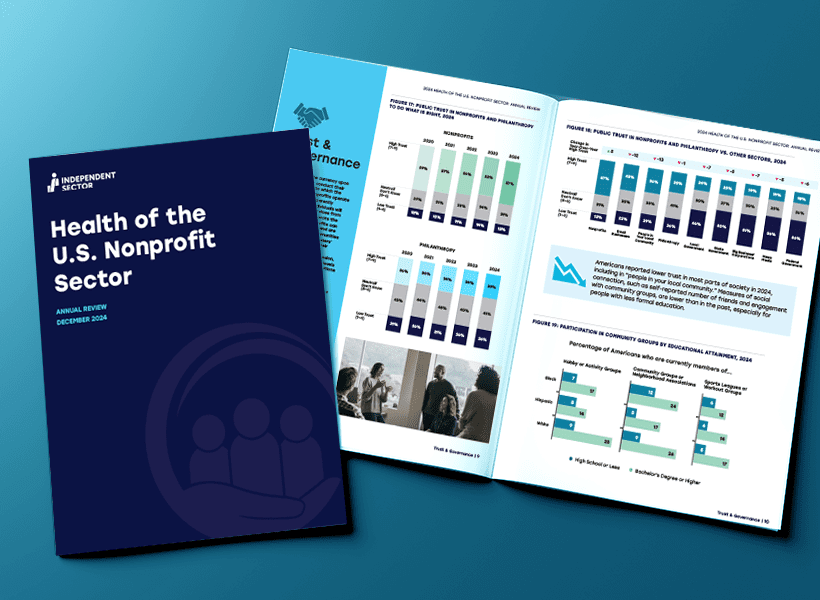During the first quarter of 2023, D.C.-based nonprofits and policymakers witnessed two impressive highwire acts. Philippe Petit performed the first act at age 73 when he walked a high-flying tightrope at the National Building Museum in Washington, D.C. Most known for walking a tightrope between the World Trade Center towers, Petit frequently juggled, ran, or reclined on wires that swayed or twisted beneath his feet. He played into the most impressive and frightening aspect of his work — the risk of falling.
The second risky highwire act was that of the U.S. nonprofit sector, which managed to deliver an impressive performance as an economic driver and employer of over 12 million people, all while balancing on an increasingly shaky financial tightrope. Independent Sector’s most recent quarterly review of data on the health of the U.S. nonprofit sector demonstrates that despite concerning declines in giving, the sector outperformed the gross domestic product, in terms of economic growth, as charitable giving and the number of donors significantly declined. The alarming drop in philanthropic support is the result of long-term downward trends that place nonprofits on very risky financial footing. Like Petit, it is impressive to watch the sector deliver in difficult circumstances. Yet, it also is terrifying knowing that stock market swings threaten to knock nonprofits off balance, which could result in disastrous consequences for both the sector and the communities it serves.
Read the June Sector Health Quarterly Report.
Nonprofit Finances and the Economy
Nonprofits demonstrated strong economic value during the first quarter of 2023, even as they experienced historic declines in charitable giving. This paradox celebrates the resilience of nonprofits, but how long can they balance as the philanthropic tightrope under their feet begins to fray?
Strong Nonprofit Contribution to Economy (But Could Be Greater)
The most recent quarterly report about nonprofit finances and their contributions to the economy provides many reasons to celebrate. U.S. nonprofits comprised 5.7% of the gross domestic product (GDP). Nonprofits’ percent of GDP typically varies between 5.5% and 5.7%, so the sector’s economic contribution is well within the norm. Growth in gross value added by nonprofits (3.4%) outpaced GDP growth (2.7%) in the first quarter of this year. These indicators and others within the quarterly review show nonprofits’ economic contributions appear to be stable and potentially growing in the first quarter of 2023.
As impressive as these economic numbers sound, nonprofit data experts believe these figures could be underestimating the sector’s economic impact. The Bureau of Economic Analysis (BEA) is the source of nonprofit economic data and categorizes nonprofits and their economic activity differently than other federal agencies. This difference means the data likely misses important nonprofit organizations and types of economic activity. If the BEA modified how it classified nonprofits within its data, the sector’s contribution to the U.S. economy could increase significantly. More specifically, the BEA currently produces statistics that take a close look at many parts of the economy: outdoor recreation, health care, arts and culture, and more. These so-called “satellite accounts” are meant to allow for in-depth analysis and increased understanding by policymakers, organizations, and researchers. A provision within the Nonprofit Stakeholders Engaging and Advancing Together (Nonprofit SEAT) Act directs the BEA to create a satellite account on the nonprofit sector. In addition to facilitating greater domestic understanding, such an account is critical for comparison with estimates developed by other countries around the globe. If your organization wants policymakers in Congress to prioritize these issues and focus on the health of nonprofits, please endorse the legislation today!
Alarming Declines in Donors and Giving
The most important news regarding nonprofits’ financial health is a notable decline in giving in 2022. Quarterly, end-of-year giving data from the Fundraising Effectiveness Project show that the number of donors declined 10% in 2022. It also indicates the dollars donated fell 1.7%. For the second consecutive year, the number of donors decreased significantly, almost entirely among donors that give less than $500. This data is echoed in the recently released Giving USA report for 2022, which reports giving may have declined as much as 10.5% when adjusted for inflation. This trend is particularly alarming because giving has declined only three times in the past 40 years (1987, 2008, and 2009).
Many policymakers hold the strong assumption that charitable giving and the financial health of nonprofits are closely tied to the state of the economy. Giving trends in 2022 show giving declining (-10.5%) at the same time GDP increased (+1.1%), indicating policymakers’ assumptions are not a guarantee and some other variables must be at play.
Both giving reports cite a volatile stock market as a key driver behind last year’s historic drop in giving. However, it is critical to understand the connection between the stock market and the decline in donors. As the sector’s donor base shrinks, many nonprofits resort to asking major donors for larger gifts to fill funding gaps, increasing the sector’s reliance on a shrinking number of donors that more likely derive their income from the stock market. When the stock market declines, major donors with large portions of their income reliant on stocks also decline, in turn decreasing charitable giving. This makes the sector’s giving more susceptible to the whims of the market as compared to the past. When the sector’s donor base was larger and included more donors from low- and middle-income households, those donors’ salaries served as a more stable source of income that could smooth out giving during times of a more volatile stock market.
So, what does this all mean for nonprofits and the communities they serve? A greater reliance on people and institutions with incomes tied to the stock market means that when the market drops, so may charitable giving. This may occur alongside spikes in community need for services, ultimately jeopardizing nonprofit and community resilience. An immediate step to address this problem is to use the tax code to incentivize all taxpayers to give, particularly those in low- and middle-income households that have stopped giving in recent years. Take action, today, and ask Congress to support the Charitable Act.
Nonprofit Workforce
Philippe Petit adamantly insists he does not pursue a career as a tightrope performer. Instead, he insists he follows his passion. Like Petit, passion is what drives a large portion of the nonprofit sector workforce to take risks every day that inspire, feed, educate, protect, and heal their communities. In the first quarter of 2023, nonprofit workforce data provide some bright spots in terms of sector health. Nonprofits make up 6.6% of the overall workforce — a 1.2% increase since the fourth quarter of 2022.
For the first time in over a year, the sector workforce grew more racially and ethnically diverse. The proportion of white workers (76.0%) remains higher than pre-pandemic levels (approximately 70%), but slightly less than the percentage of white workers in the overall workforce. In general, the racial and ethnic proportions of the nonprofit workforce track with demographics of the broader workforce, except for Hispanic workers. The exact cause for the disparity for Hispanic workers is unclear and would benefit from further research.
From a wage perspective, the proportion of workers earning over $75,000 outpaced the overall workforce. The sector also saw a significant decline in the number of employees earning less than $40,000.
While the sector continues to wrestle with a variety of workforce issues – burnout, talent recruitment and retention, and inadequate incentive structures – these latest data points are a welcomed sign that we can make progress.
A Continuing Uncertainty
When reflecting on the totality of the nonprofit sector’s first quarter high-wire act, there is a critical difference between its performance and Petit’s performance. Petit says he is not afraid when he performs because he meticulously plans and trains to ensure the environment in which he performs is as secure as possible.
Nonprofits cannot say the same. Unless Congress and everyday donors take action to stabilize the environment in which the sector works, nonprofits fear whether they’ll be able to keep up this balancing act for much longer.
Read the June Sector Health Quarterly Report.
Updated as of November 27, 2023.



